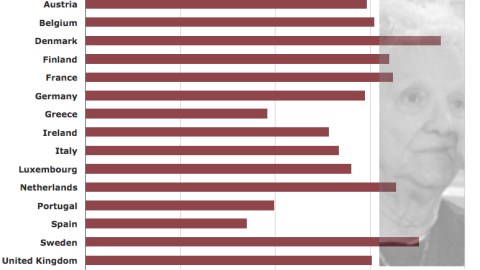Mother’s Day & Households of One: Older Women and a Global Trend Business & Government Can’t Ignore

It’s Mother’s Day. Are you thinking about mom? No, not because it’s Mother’s Day, but because mom is a trendsetter a virtual thermometer of what’s hot and what’s not. I am not referring to today’s much-studied chief consumer officer of the home caught between kids, parents, partner, work and so much else. I am talking about today’s older mom who is over 60 years old, what she means to business and government, as well as what she may foreshadow for today’s middle-aged woman tomorrow.
Mom Goes Solo
For some, Mother’s Day conjures up images of flowers, cards, gifts and homes crowded with children and grandchildren. That may be the case – for a day. But, after the dinner is done and the family waves its last good-bye, mom is very likely to be a household-of-one. A combination of personal preferences, divorce, moving decisions of adult children, male mortality, and life events has contributed to the reality that many older women live alone.
Here are the numbers in the United States. According to the US Census Bureau 40% of women over 65 years old live alone compared to only 19% of their male counterparts. While Hispanic and Asian women over 65 are less likely to live alone there are still about 20% of them living independently. In sharp contrast, nearly 42% of non-Hispanic white women and 39% of African-American women lead solo lives after 65 years old.
I can hear mumbling from some of you…‘older people aging alone is an American thing’…. perhaps, but it must be a fast selling export as well. Living arrangements of older women are changing in Europe and Asia as well.
Households-of-One Go Global
According the United Nations, Europe and North America are about equal in their respective proportions of older women and men living alone. Approximately 26% of people 60 years old and older live alone in both Europe and North America.
But, there is a wide range within those averages. European Union 15 or EU15 data shows stark regional differences between northern and southern Europe. Sweden leads with nearly 53% of women over age 65 living alone. In contrast, Spain has only 25% of women 65+ living solo.
Traditional household structure in Asia is changing as well. United Nations data provides a few examples. In 1986, 77% of adults over age 60 in Thailand lived with family compared to 59% in 2007. Japan reports that 70% of adults over age 65 lived with family members in 1980 compared to only 43% in 2005. Earlier this year China’s government announced that it was considering making a law requiring adult children to visit elderly parents as a means to address a growing care gap.
South America and Africa still have most older adults living with family – only 11% and 8% of older adults living alone on those continents respectively. If living arrangements are a product of changing lifestyles driven by economic development over time will more African and South American older women find themselves living solo?
Insights & Innovations
What do older women in households-of-one mean for business and government innovation? Many are quick to jump to the loneliness factor. While older women may be living alone, this does not necessarily mean they are lonely. Generally women show remarkable resilience and capacity to remain connected and engaged after traditional working age compared to men. In other cases family may not be in the home, but nearby. ‘Householdsof-one’ do present many practical implications. Here are just a few:
Smaller Everything – smaller households change demand. The most obvious impact will be on big boxes (and many big box stores) that do not have a place in the lives of people who live in small households. A can or two of something is sufficient instead of a case that is both too heavy and too much to eat for one.
Finance & Insurance – Financial services firms, insurers and retirement advisers must respond to the new reality that many of their clients are today – and more tomorrow – will be women. Planning and products that engage both partners is key to address future needs as well as keeping a household (not an individual) as a client. Financial products that promise independence for the long-term will be critical.
Independent Living Services – Nothing motivates like guilt. Adult children living at a distance may drive growth in technology-enabled services that keep mom in touch or in easy reach of support. Adult children, even their employers, may find that direct purchase of services that monitor well-being, provide emergency services, food delivery, transportation, etc., will not only be good for mom but be key to reducing the risk of a catastrophic event and enabling a productive workforce that needs to care from a distance. As we look to the next generation of older women, they will have fewer children, be better educated and have larger incomes than older women today. They will individually demand, finance and assess quality services to ensure their personal well-being.
Home Maintenance & Modification –New businesses and public programs are likely to emerge to help older women clean and maintain the house, extend independence at home by modifying and remodeling the home to ensure usability and accessibility across the lifespan.
Trusted Providers – Selected companies with trusted brands, NGOs, and government agencies are likely to expand their services to people in their service area and become the distant caregivers ‘go to’ source for information, identifying, financing and monitoring the services they will need to care for mom or for older adults to care for themselves.
Social Services – Even for the toughest among us, living alone has its challenges. Social services and support to manage daily activities and ensure physical and emotional well-being will be needed by many. Particularly those who may not have access to the technology, services and social network that will enable others to thrive solo.






